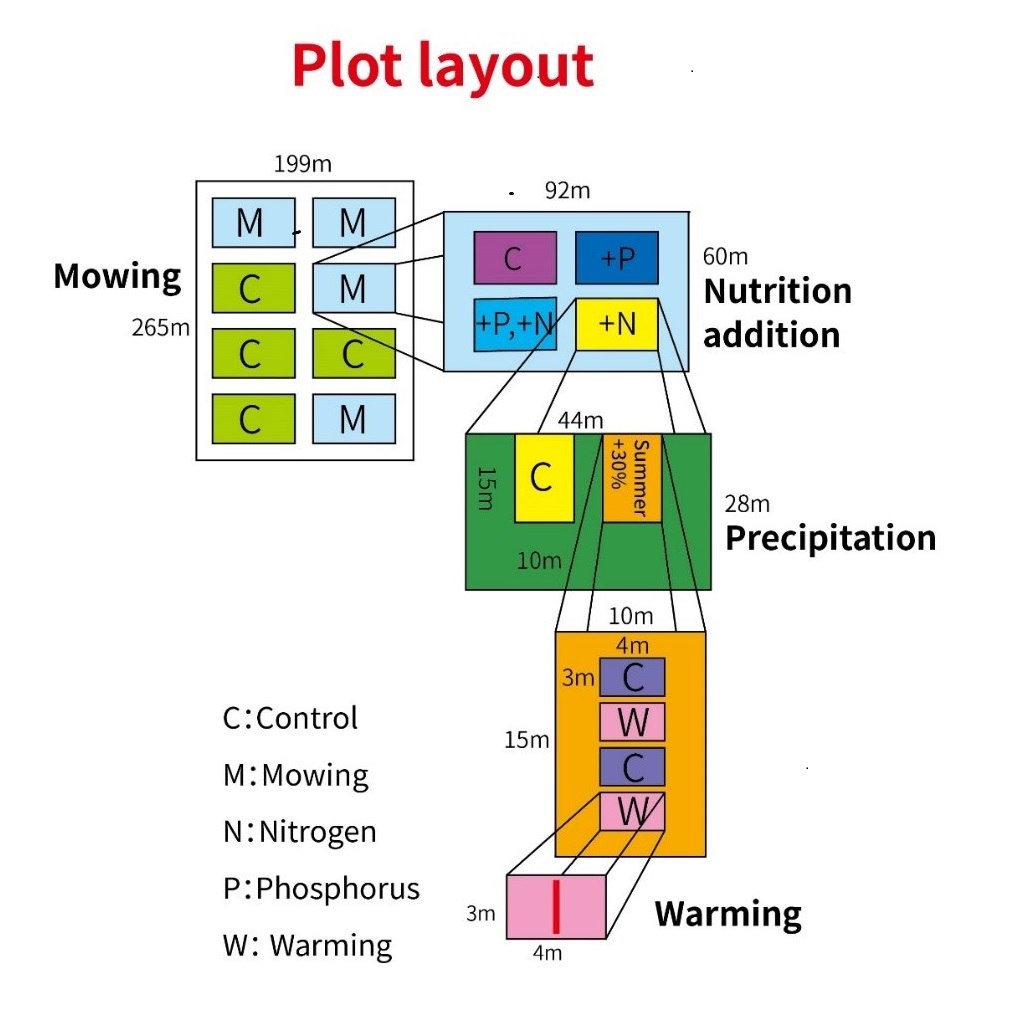全球变化多因子实验平台介绍
实验背景
自工业革命以来,化石燃料燃烧及土地利用改变等人类活动的加剧导致大气中温室气体浓度急剧上升,进而引发全球范围的气候变暖。气候变暖会进一步加剧全球水文循环,并导致全球和区域降水格局发生改变。此外,人类大量施用氮肥以及化石燃料的燃烧也导致大气中的活性氮沉降速率逐年增加。土地利用变化、气候变暖、降水格局变化以及活性氮沉降速率增加等全球变化驱动因子对陆地植物生长和碳循环过程具有重要影响。草地占全球陆地面积的40%并储存了陆地生物圈近1/3的有机碳,对全球碳平衡具有重要贡献。位于我国北方干旱和半干旱地区的温带草地是欧亚大陆草原的重要组成部分,该生态系统相对脆弱,对人类活动干扰和气候变化十分敏感。过去的大量研究证明,土地利用改变(刈割)、增温、增雨以及氮添加会显著改变该半干旱草原的植物生长、群落组成以及碳循环过程。但是,气候变化是长期而缓慢的过程,在长时间尺度上,该生态系统如何响应于以上全球变化驱动因子仍不清楚。此外,全球变化的驱动因子并不是孤立存在,在这些驱动因子共同作用下,是否会对该生态系统结构和功能产生交互影响还存在很大的不确定性,这也给地球系统模型预测未来全球变化如何影响陆地碳循环造成了一定的困难和挑战。因此,本研究于2005年设立多因子实验,通过实施刈割、增温、增雨以及氮添加处理来探究温带半干旱草原对全球变化多项驱动因子在长时间尺度上的响应。

实验设计
全球变化多因子实验建于2005年,本实验采用嵌套设计(如下图),有四级处理,占地面积为199 m× 265 m,共有8个一级区组处理,由北向南分为四行两列,相邻两个区组之间有5 m间隔的缓冲带。一级割草和不割草处理随机分布,每种处理4个重复。刈割处理是在每年8月中下旬进行,留茬10 cm,并且及时将割除的地上植被移出样地。
每个一级区组划分为4个44 m × 28 m的二级小区,相邻二级小区之间有1 m宽的缓冲带。对照、施氮、施磷、氮磷同施四个处理随机分布。7月中旬对样地进行营养添加,氮添加处理选用尿素,磷添加处理选用过磷酸钙,添加量分别为10 g N m-2 year-1,5 g P2O5 m-2 year-1。
在二级小区内的对照和氮素添加处理的基础上设定三级处理,分别设置2个10 m × 15 m的增雨处理,包括对照和夏季增雨。采用自动喷水装置,每个降水区有6个喷水装置,被均匀地布置成两排,每两个喷水装置之间的距离为5 m。在每年7月和8月进行夏季增雨处理,每年的增雨总量为120 mm,分两个月进行处理,每个月的降水处理分4次进行,每次增雨量为15 mm。
在三个既不刈割也不进行营养添加的对照和增雨样地中均设有4个3 m × 4 m的增温小区,相邻两个小区之间间隔1 m。四级设有对照、增温、增雨、增温+增雨4个处理,每个处理两个重复。增温处理自2005年开始,于2016年停止,并观察增温处理后的恢复。

发表文章
Du, Y., H. Han, Y. Wang, M. Zhong, D. Hui, S. Niu, and S. Wan. 2018. Plant functional groups regulate soil respiration responses to nitrogen addition and mowing over a decade. Functional Ecology 32:1117-1127.
Han, H., Y. Du, D. Hui, J. Lin, M. Zhong, and S. Wan. 2017. Long-term antagonistic effect of increased precipitation and nitrogen addition on soil respiration in a semiarid steppe. Ecology and Evolution 7:10804-10814.
Li, G., H. Han, Y. Du, D. Hui, J. Xia, S. Niu, X. Li, and S. Wan. 2017. Effects of warming and increased precipitation on net ecosystem productivity: A long-term manipulative experiment in a semiarid grassland. Agricultural and Forest Meteorology 232:359-366.
Gao, C., Y. Kim, Y. Zheng, W. Yang, L. Chen, N. Ji, S. Wan, and L. Guo. 2016. Increased precipitation, rather than warming, exerts a strong influence on arbuscular mycorrhizal fungal community in a semiarid steppe ecosystem. Botany 94:459-469.
Song, B., S. Niu, and S. Wan. 2016. Precipitation regulates plant gas exchange and its long-term response to climate change in a temperate grassland. Journal of Plant Ecology 9:531-541.
Wu, T., F. Su, H. Han, Y. Du, C. Yu, and S. Wan. 2014. Responses of soil microarthropods to warming and increased precipitation in a semiarid temperate steppe. Applied Soil Ecology 84:200-207.
Chen, Y., H. Hu, H. Han, Y. Du, S. Wan, Z. Xu, and B. Chen. 2014. Abundance and community structure of ammonia-oxidizing Archaea and Bacteria in response to fertilization and mowing in a temperate steppe in Inner Mongolia. FEMS Microbiology Ecology 89:67-79.
Chen, Y., X. Zhang, J. Ye, H. Han, S. Wan, and B. Chen. 2014. Six-year fertilization modifies the biodiversity of arbuscular mycorrhizal fungi in a temperate steppe in Inner Mongolia. Soil Biology and Biochemistry 69:371-381.
Zhou, X., C. Chen, Y. Wang, Z. Xu, H. Han, L. Li, and S. Wan. 2013. Warming and increased precipitation have differential effects on soil extracellular enzyme activities in a temperate grassland. Science of the Total Environment 444:552-558.
Zhang, N., W. Liu, H. Yang, X. Yu, J. L. M. Gutknecht, Z. Zhang, S. Wan, and K. Ma. 2013. Soil microbial responses to warming and increased precipitation and their implications for ecosystem C cycling. Oecologia 173:1125-1142.
Sun, X., Y. Su, Y. Zhang, M. Wu, Z. Zhang, K. Pei, L. Sun, S. Wan, and Y. Liang. 2013. Diversity of arbuscular mycorrhizal fungal spore communities and its relations to plants under increased temperature and precipitation in a natural grassland. Chinese Science Bulletin 58:4109-4119.
Song, B., S. Niu, Z. Zhang, H. Yang, L. Li, and S. Wan. 2012. Light and heavy fractions of soil organic matter in response to climate warming and increased precipitation in a temperate steppe. PLoS ONE 7:e33217.
Yang, H., L. Jiang, L. Li, A. Li, M. Wu, and S. Wan. 2012. Diversity-dependent stability under mowing and nutrient addition: Evidence from a 7-year grassland experiment. Ecology Letters 15:619-626.
Li, Y., H. Yang, J. Xia, W. Zhang, S. Wan, and L. Li. 2011. Effects of increased nitrogen deposition and precipitation on seed and seedling production of potentilla tanacetifolia in a temperate steppe ecosystem. PLoS ONE 6:e28601.
Niu, S., X. Xing, Z. Zhang, J. Xia, X. Zhou, B. Song, L. Li, and S. Wan. 2011. Water-use efficiency in response to climate change: From leaf to ecosystem in a temperate steppe. Global Change Biology 17:1073-1082.
Yang, H., Y. Li, M. Wu, Z. Zhang, L. Li, and S. Wan. 2011. Plant community responses to nitrogen addition and increased precipitation: The importance of water availability and species traits. Global Change Biology 17:2936-2944.
Yang, H., M. Wu, W. Liu, Z. Zhang, N. Zhang, and S. Wan. 2011. Community structure and composition in response to climate change in a temperate steppe. Global Change Biology 17:452-465.
Wu, M., S. Niu, and S. Wan. 2010. Contrasting effects of clipping and nutrient addition on reproductive traits of Heteropappus altaicus at the individual and population levels. Ecological Research 25:867-874.
Bai, W., S. Wan, S. Niu, W. Liu, Q. Chen, Q. Wang, W. Zhang, X. Han, and L. Li. 2010. Increased temperature and precipitation interact to affect root production, mortality, and turnover in a temperate steppe: Implications for ecosystem C cycling. Global Change Biology 16:1306-1316.
Niu, S., M. Wu, Y. Han, J. Xia, Z. Zhang, H. Yang, and S. Wan. 2010. Nitrogen effects on net ecosystem carbon exchange in a temperate steppe. Global Change Biology 16:144-155.
Niu, S., H. Yang, Z. Zhang, M. Wu, Q. Lu, L. Li, X. Han, and S. Wan. 2009. Non-additive effects of water and nitrogen addition on ecosystem carbon exchange in a temperate steppe. Ecosystems 12:915-926.
Liu, W., Z. Zhang, and S. Wan. 2009. Predominant role of water in regulating soil and microbial respiration and their responses to climate change in a semiarid grassland. Global Change Biology 15:184-195.
Niu, S., M. Wu, Y. Han, J. Xia, L. Li, and S. Wan. 2008. Water-mediated responses of ecosystem C fluxes to climatic change in a temperate steppe. New Phytologist 177:209-219


